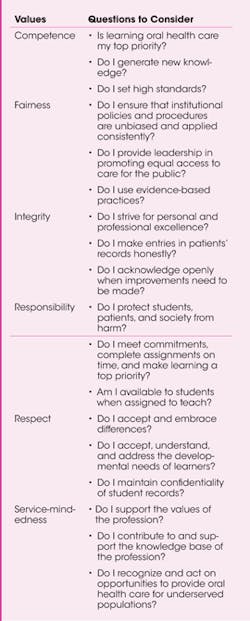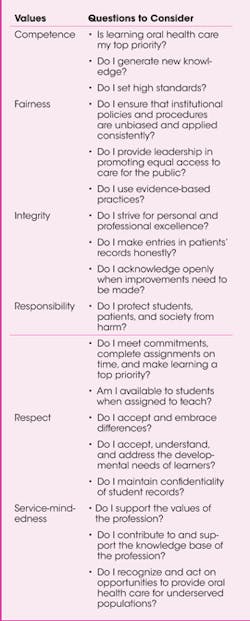Infection control: A bugaboo
by JoAnn R. Gurenlian, RDH, PhD
Years ago, when we were first married, my husband commented that our home was "like a clinic." I wanted the kitchen to be pristine, with no messes on the counter, dishes washed and tucked away in their cabinets, and the floors dust free. I wanted the bathrooms cleaned every other day at least, and the beds made. Once we had children, I noticed a slippery slide in standards, and we bowed to the needs of the kids to play and be cared for rather than worry about the cleanliness of the house. With time, my clinic-like home looked more loved and lived-in than clean.
During those early child-raising years, I started noticing that I was not the only one with a slip in cleanliness standards. I saw parents of infants pick up a pacifier that fell out of the baby's mouth, "wash" it in their own mouth, and pop it right back into that infant's mouth. Then there was the five-second rule. Something fell on the floor, and if it landed and was picked up within a few seconds, one could eat it without worrying about germs. Really, how dirty could it be?
-----------------------------------------------------------
Other articles by Gurenlian
-----------------------------------------------------------
Of course, in our dental hygiene practices, we have higher standards for infection control. We don't drop a curette in front of a patient, pick it up and say "five-second rule," and place it back in the patient's mouth. We follow infection control standards promoted by the CDC, OSHA, OSAP, and the ADHA. All instruments are cleaned, bagged, and sterilized. Counters and other surfaces are wiped down. We wear gloves, glasses, masks, and protective clothing to reduce the likelihood of disease transmission. We use caution with syringes and sharp objects, and dispose of infectious waste according to federal, state, and local regulations. We use protective coverings on light handles and radiographic machines. We wash our hands constantly. We pride ourselves on the numerous precautions we take to reduce the potential for disease transmission among our patients and our coworkers.
So, how did it happen then that a dentist in Tulsa, Oklahoma, had unsanitary dental practices and exposed approximately 7,000 patients to HIV, hepatitis B, and hepatitis C? Or, how is it that at a prestigious hospital in Philadelphia, instruments used for colonoscopy procedures were not properly sterilized and then used on patients? This story was followed closely on the heels of another story about a physician who used rusty instruments to perform illegal abortions. With all the regulations that exist for infection control and prevention of disease transmission, how are these cases occurring? Is this similar to our home situations, where we allow our standards to slip a bit, and slip some more?
In our heart of hearts, we all strive for the highest standards in practice. But how do we know we are accomplishing that goal? What are our practices for reducing the transmission of disease in our office settings? When was the last time we reviewed this concept at a staff meeting or performed a random check on one another in the office? When was the last time we visited an infection control website and compared our practices to the standards?
Some offices have an appointed infection control officer for the practice. Some offices require yearly training in effective infection-free delivery of care. If your office does not have this level of care, maybe it's time to revisit the need for coordinated infection control. Appoint yourself as the keeper of infection control practices. Review the policies and procedures of the office that relate to infection control. Research some of the organizations that provide information about management and prevention of infectious diseases, and update yourself on the standards that are expected in practice settings. Table 1 provides some resources that may be useful for this exercise.
We can all shake our heads at the situation in Tulsa, and we're grateful that we're not lowering our standards. Let's just make sure that we're upholding those standards. Our patients will be grateful for our efforts to provide disease-free oral health care. RDH
JOANN R. GURENLIAN, RDH, PhD, is president of Gurenlian & Associates, and provides consulting services and continuing-education programs to health-care providers. She is a professor and interim dental hygiene graduate program director at Idaho State University, and president-elect of the International Federation of Dental Hygienists.
Past RDH Issues

